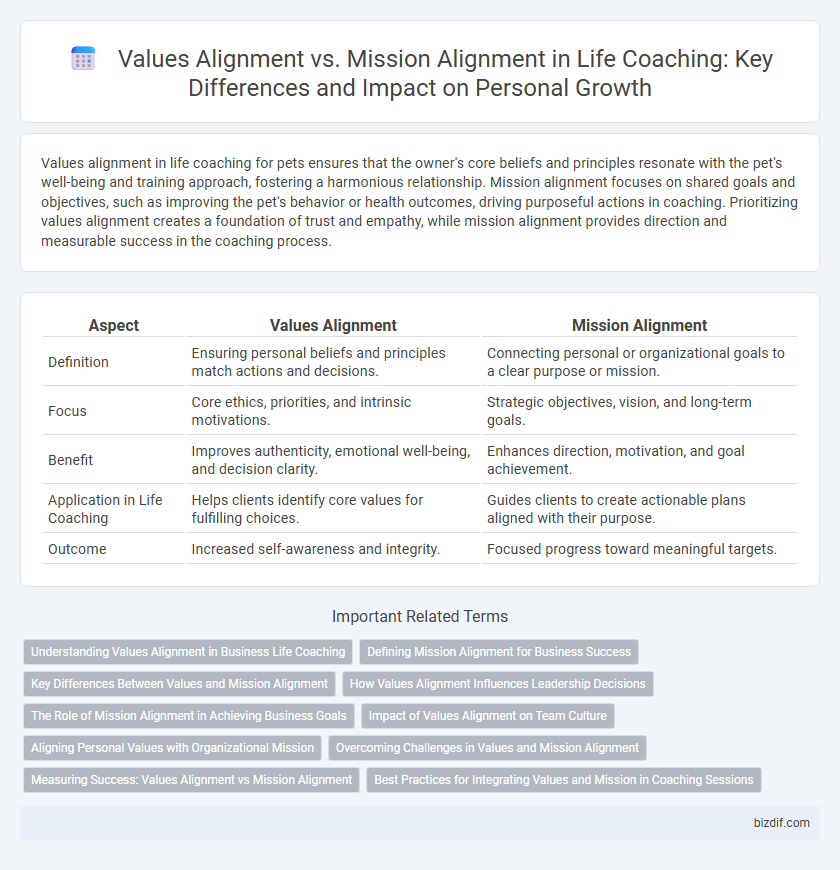Values alignment in life coaching for pets ensures that the owner's core beliefs and principles resonate with the pet's well-being and training approach, fostering a harmonious relationship. Mission alignment focuses on shared goals and objectives, such as improving the pet's behavior or health outcomes, driving purposeful actions in coaching. Prioritizing values alignment creates a foundation of trust and empathy, while mission alignment provides direction and measurable success in the coaching process.
Table of Comparison
| Aspect | Values Alignment | Mission Alignment |
|---|---|---|
| Definition | Ensuring personal beliefs and principles match actions and decisions. | Connecting personal or organizational goals to a clear purpose or mission. |
| Focus | Core ethics, priorities, and intrinsic motivations. | Strategic objectives, vision, and long-term goals. |
| Benefit | Improves authenticity, emotional well-being, and decision clarity. | Enhances direction, motivation, and goal achievement. |
| Application in Life Coaching | Helps clients identify core values for fulfilling choices. | Guides clients to create actionable plans aligned with their purpose. |
| Outcome | Increased self-awareness and integrity. | Focused progress toward meaningful targets. |
Understanding Values Alignment in Business Life Coaching
Values alignment in business life coaching centers on ensuring a client's personal core beliefs resonate with their professional actions and decisions, fostering authenticity and fulfillment. This alignment enhances motivation, ethical behavior, and long-term satisfaction by bridging internal values with workplace culture and goals. Distinguishing this from mission alignment, which emphasizes organizational objectives, highlights the transformative power of individual value coherence for sustainable career success.
Defining Mission Alignment for Business Success
Mission alignment in business entails ensuring that every strategy, goal, and action directly supports the core purpose and long-term vision of the company, driving cohesive growth and measurable impact. It requires translating overarching values into specific objectives that resonate with stakeholders and foster commitment at all organizational levels. Achieving mission alignment enhances operational efficiency, strengthens brand identity, and accelerates sustainable business success by uniting teams behind a clear, purpose-driven direction.
Key Differences Between Values and Mission Alignment
Values alignment centers on ensuring personal or organizational actions reflect core beliefs and ethical principles, fostering authenticity and long-term commitment. Mission alignment, however, emphasizes coherence with defined goals and strategic objectives, driving purposeful direction and measurable outcomes. The key difference lies in values guiding why actions matter at a fundamental level, whereas mission alignment focuses on how actions achieve specific aims.
How Values Alignment Influences Leadership Decisions
Values alignment in leadership deeply influences decision-making by ensuring choices resonate with core ethical principles and personal integrity, fostering trust and authenticity in teams. This alignment drives consistent behavior that motivates employees, promotes organizational culture, and guides strategic priorities. Leaders committed to values alignment make decisions that support long-term vision and stakeholder engagement, enhancing overall effectiveness and sustainability.
The Role of Mission Alignment in Achieving Business Goals
Mission alignment ensures that every business decision and strategy directly supports the company's core objectives, facilitating measurable progress toward specific goals. This focused approach enhances team cohesion and resource allocation, maximizing productivity and return on investment. Unlike values alignment, which centers on ethical and cultural consistency, mission alignment drives actionable outcomes critical for business success.
Impact of Values Alignment on Team Culture
Values alignment fosters a cohesive team culture by ensuring all members share core beliefs, enhancing trust and collaboration. This alignment directly influences motivation and engagement, leading to higher productivity and job satisfaction. In contrast, mission alignment emphasizes objectives but may overlook the underlying cultural harmony that values alignment nurtures.
Aligning Personal Values with Organizational Mission
Aligning personal values with an organization's mission fosters authentic engagement and drives meaningful contributions in life coaching. When individual ethics resonate with corporate goals, motivation and job satisfaction increase, enhancing overall performance. This alignment cultivates a cohesive work environment where personal purpose and organizational objectives thrive in harmony.
Overcoming Challenges in Values and Mission Alignment
Overcoming challenges in values and mission alignment requires a clear understanding of core personal values and the broader organizational or life mission to ensure consistency and motivation. Life coaching strategies focus on identifying misalignments that cause internal conflict or decision-making paralysis, facilitating realignment through reflective exercises and goal-setting interventions. Ensuring congruence between values and mission strengthens commitment, enhances resilience during setbacks, and supports sustained progress toward meaningful objectives.
Measuring Success: Values Alignment vs Mission Alignment
Measuring success in life coaching requires distinguishing between values alignment and mission alignment, where values alignment tracks consistency with core personal beliefs, fostering authentic motivation and long-term satisfaction. Mission alignment evaluates progress based on achieving specific goals that fulfill an overarching purpose, emphasizing actionable outcomes and strategic milestones. A balanced approach integrates both metrics, ensuring individualized fulfillment alongside tangible achievements in coaching processes.
Best Practices for Integrating Values and Mission in Coaching Sessions
Integrating values and mission in coaching sessions requires coaches to facilitate deep self-reflection, helping clients articulate core personal values and align them with their broader mission statements for authentic goal setting. Utilizing tools like values clarification exercises and mission statement drafting worksheets enhances client awareness and ensures that action plans resonate with intrinsic motivations. Best practices include consistent revisiting of these alignments throughout the coaching process to maintain clarity and drive sustainable, purpose-driven progress.
Values alignment vs Mission alignment Infographic

 bizdif.com
bizdif.com